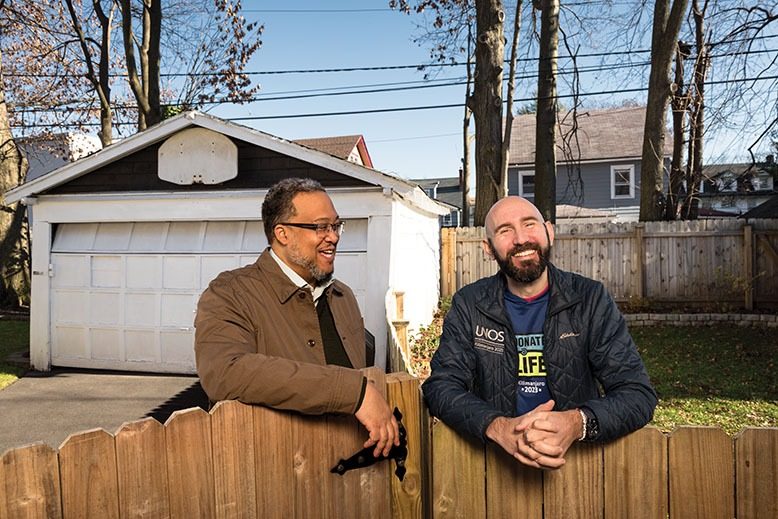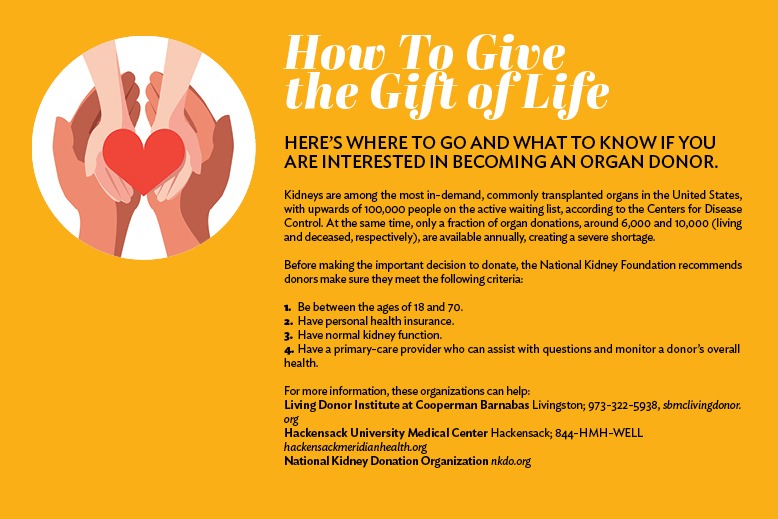
When Steve and Judy Mura moved to South Orange in 2017, they became friendly with their next-door neighbors, Michael and Miriam Sang. The couples chatted, spent time outside together with their children, and had joint barbecues. But over time, the Muras realized that their friend Michael Sang was no longer outside barbecuing, and that he was using a cane to walk. Concerned, Judy Mura asked Miriam Sang if he was okay. She was saddened to learn that he was far from it; Michael Sang had kidney failure caused by an aortic hematoma, a condition in which blood leaks through the aortic wall. He desperately needed a kidney transplant.
In an extraordinary gesture, Judy Mura offered to donate one of her kidneys to her neighbor. “I wanted to help him and his family,” she says. “Also, my father had a liver transplant, so I had a special connection to Mike needing an organ donor.”
But, alas, she was not a match for Michael Sang, who is now 49 years old. So, in another incredible act of kindness, her husband, Steve Mura, who is now 38 years old, offered to donate a kidney. Fortunately, this time it was a match.
Kidney donations often come from family members, but friends, colleagues and even strangers volunteer in about equal numbers. “Kidney donations have extended beyond family members,” says Dr. Praveen Kandula, medical director of the Living Donor Institute at Cooperman Barnabas Medical Center. “More than half the donations [in the country] are from unrelated people, such as friends and acquaintances.”
Sang’s health issues began in 2020. “I was lying in bed, exhausted, unable to eat,” he recalls.
“Food, even water, started to taste like poison.” Realizing something was very wrong, Sang contacted his primary care physician, who wanted to run tests but, because of the pandemic, couldn’t schedule an appointment in a timely fashion.
Meanwhile, his condition worsened. His wife, alarmed at how quickly he was deteriorating, rushed him to the hospital, where Sang found out he had kidney failure. The news left him in shock. “It was very traumatic,” he says. “My world just crashed.”
Sang, who works in billing for the Hospital for Special Surgery in Manhattan, immediately started dialysis, an intense and time-consuming treatment that removes waste from the body when a person’s kidneys can no longer do the job. “All of a sudden, I was in a chair with big needles in my arm,” says Sang, who was on dialysis three times a week for two years. Each session lasted four hours.
Dialysis was keeping him alive, but it was punishing his body.
“It beat me down so much that I didn’t know how much longer I could do it,” he says. “I would drive myself home, crawl up the steps, and get into bed for two days to recover.”
According to Kandula, dialysis is not a good option for kidney failure. “A machine can never replicate the function of a human organ,” he says. “A transplant is much better than being on dialysis.”
Sang desperately needed a kidney transplant, but it wasn’t going to be easy. He was required to undergo thorough testing before he could be cleared to receive a kidney, due to his aortic hematoma. Once testing was complete, he needed to find someone willing to donate a kidney.
Since the outcome is more favorable when a kidney comes from a living donor, Sang needed the generosity of someone special.
Steve Mura says that, when he first met Sang, he never dreamed that he would one day be saving his neighbor’s life. Sang was equally surprised. “My next-door neighbor was a match; what are the odds of that?” he says. “If the wives didn’t coordinate with each other, I’d probably still be on dialysis and waiting for a kidney.”
Sang and Mura underwent surgery in June of 2022 at the Renal and Pancreas Transplant Division at Cooperman Barnabas. Mura’s kidney was removed laparoscopically, through two small holes. A camera connected to a monitor, providing the surgeon with a clear view of the area, was placed in one hole; the second hole provided a space for the surgeon’s tools. Sang was then able to receive the kidney through traditional open surgery.
Both surgeries lasted about an hour. Donors are usually discharged from the hospital the day after surgery. Recipients go home after a few days and can resume their normal activities in about 10 days.
“I feel very blessed,” says Sang, whose recovery has been a little slower because of his aortic hematoma. He says, “I have more energy, with a better quality of life.”
An unexpected match
Because she has no children of her own, 61-year-old Judy Herman wanted to give life in some other way. “I saw a TV program where a contestant promoted the idea of living-donor donation,” says Herman, an emergency room billing specialist at the Valley Hospital in Ridgewood and a volunteer EMT. “I had no idea that was a thing, and I googled, How to go about donating an organ.”
In 2019, the Emerson resident went to the hospital for testing to ensure that she was healthy enough to become a donor. Unexpectedly, a CT scan of her abdomen found a large, benign mass on her spleen. Doctors removed her spleen and, after waiting six months, she was able to move forward with her plans to donate a kidney.
“I needed to give my kidney to someone who needed it,” Herman says.

Judy Herman of Emerson donated a kidney to Park Ridge firefighter Mark Eisen after reading about his need in a local newspaper. Photo: Peter Murphy
At first, Herman thought she would be a non-directed donor, meaning the kidney would go to an unknown recipient. But, as it turned out, her gift would restore the life of someone she knew
In 2021, Herman saw an article in a local paper about 63-year-old Mark “Cookey” Eisen, a firefighter, needing a kidney. She knew Eisen from a shared event with the Park Ridge Fire Department and the Ambulance Corps, where she volunteered as an EMT for Triboro Ambulance.
A former Navy cook, where he earned the nickname Cookey, Eisen did all the cooking at the firehouse.
Herman contacted Eisen, then a resident of Park Ridge, and, after learning that they both had B-positive blood types, she logged onto the Hackensack University Medical Center website, where Eisen was on the waiting list for a transplant. She filled out an application specifying that she wanted to be Eisen’s donor. She was a match.
“Judy saved my life,” says Eisen, whose kidney troubles, due to type 2 diabetes, started eight years ago.
The doctors informed Eisen that, if a kidney wasn’t found, he would need dialysis.
Eisen knew that the wait for a kidney in New Jersey was four to nine years but as a minor celebrity in Park Ridge—Eisen’s volunteer work for the fire department, Elk’s Club American Legion, and board of Triboro Ambulance Corps, was well known—people came forward. In fact, 32 people offered a kidney, and the best match was Herman.
“Cookey is a special guy,” says Herman.

When Herman, Eisen and Eisen’s wife met, they ended up spending a three-hour dinner together and forming a bond. “We’ve been friends ever since,” says Eisen.
Things moved quickly after the three met. Eisen wanted to have the surgery as soon as possible so that he could be healthy enough to attend his son’s wedding on Martha’s Vineyard on Memorial Day weekend of 2021.
On April 5, 2021, Eisen and Herman were in adjoining operating rooms at Hackensack University Medical Center. Herman’s kidney was removed laparoscopically and placed into Eisen’s abdomen using open surgery. Eisen was in the hospital for five days. After six weeks, he was back to his job as a manager in the dental industry. He’s also resumed volunteering at the firehouse, and, after being the sole cook there for 30 years, he’s still making his specialties: paella, burgers and ribs. Herman was home 24 hours after surgery and, six weeks later, returned to her full workload as an EMT for Dispatch Health, a mobile urgent-care service.
“I’m living a healthier life,” says Eisen, who was able to attend his son’s much-anticipated wedding. “I want to be around for my grandkids and live as long as possible.” As a token of gratitude, Eisen presented Herman with a silver kidney on a Tiffany & Co. chain.
Both Herman and Eisen now volunteer as mentors for donors and recipients, sharing their experience and knowledge. “It’s not just doing something for someone else, but also for yourself,” Herman says.
Herman mentors potential donors through the National Kidney Donation Organization. “Most potential donors want to know about the surgery, the recovery, and any restrictions following donation,” she says. “I also guide them through the tests needed for consideration to be a donor and benefits offered through the National Kidney Registry, which covers expenses and lost wages.”
Eisen mentors patients awaiting a kidney through the Patient to Patient Monitoring Program of Quality Insight Network 3. “Before my transplant, a mentor walked me through the steps and gave me information, so I wanted to do the same for others,” he says. “The transplant team provides information, but patients seem to feel more confident talking to someone who has had a transplant.”
The need is great
According to the National Kidney Foundation, the organ most commonly donated is the kidney, with a transplant from a living donor lasting about twice as long as one from a deceased donor (approximately 12-20 years for a living donor versus 8-12 years for a deceased donor). In 2022, there were 620 donors in New Jersey, 240 living and 380 deceased, according to the Organ Procurement and Transplantation Network.
“Thanks to social media and increased information about donating, more people are donating kidneys,” says Dr. Kandula. Still, he says, there aren’t enough people to meet the demand of patients who need a kidney. In 2021, more than 2,300 New Jerseyans were on the kidney transplant waiting list.
When Steve Mura decided to donate one of his two kidneys to his neighbor, the decision was partly inspired by his father-in-law, who had received a liver transplant from a deceased donor.
Mura says the new liver gave his father-in-law a good life and a chance to enjoy spending time with his young grandchildren. “We were very grateful,” says Mura. “I wanted Mike to have the opportunity, too, for a good life.”
Still, Mura gave a lot of thought to his decision. “I’m an athlete,” he explains. “I needed to know if I would be able to continue as an athlete.”
As an avid runner, professional running coach, and manager of runner training and education for New York Road Runners, Mura questioned the effects, if any, of losing a kidney. When the doctors told him he would still be able to run, except during a short period after surgery, his mind was made up.
Mura went through extensive testing to make sure that his kidney was healthy and that he was strong and well enough to live with just one kidney for the rest of his life.
Awaiting the surgery, Mura ran a half-marathon in every month from January until June 2022. “I wanted to be in the best shape possible for the surgery, and to make sure I’d be fit after the surgery,” he says.
Mura’s recovery went well. “I was never in pain; the only frustration was not being allowed to lift my children for a while,” he says. “I did this for Mike and his family. It’s great to see him walking without a cane and back outside doing yard work.”
To demonstrate the normalcy of life after donating a kidney, Mura picked World Kidney Day in 2023 to climb Mount Kilimanjaro, the tallest mountain in Africa. He climbed with the group Living Donor Adventures, a nonprofit that brings awareness to organ donation through life-affirming adventures. “Whatever your summit is, you can do it,” says Mura of what the trip showed. Mura then ran the London Marathon a month later.
“When one kidney is removed, the other kidney picks up the slack,” explains Kandula. “There is an initial lull and, in three to six months, kidney function comes up from 50 percent to 70-75 percent. You can live normally with 80 percent; it’s more than enough to carry you through your life going forward.”
He uses the analogy of a car with a gas tank that’s half full, saying, “The car doesn’t drive any differently with half a tank of gas.”
Eleanor Gilman is a frequent contributor to New Jersey Monthly.
No one knows New Jersey like we do. Sign up for one of our free newsletters here. Want a print magazine mailed to you? Purchase an issue from our online store.
